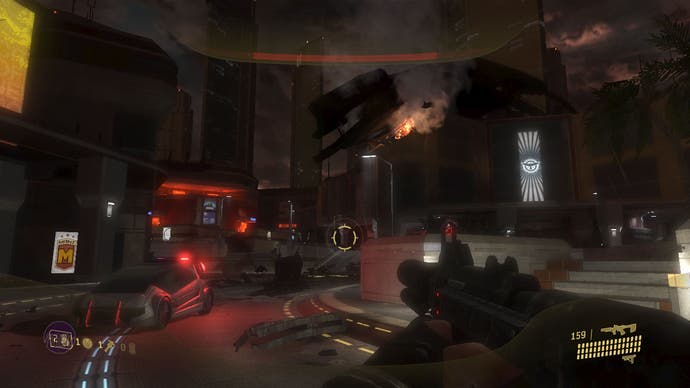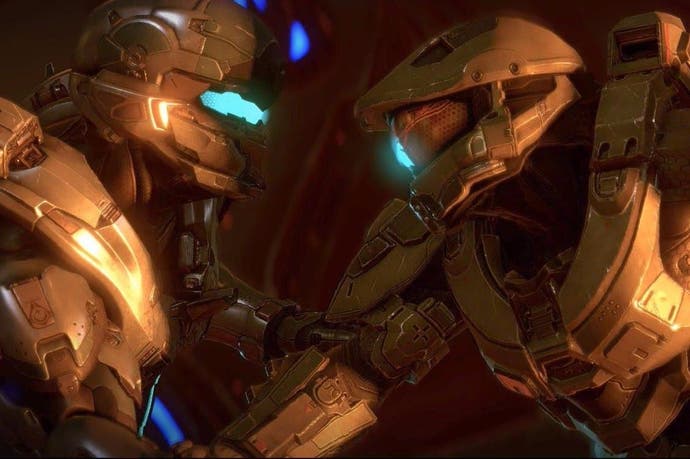Why Halo's biggest problem may be Halo itself
And what Halo 5 might have learned from Halo 3: ODST.
The original Halo Wars ends by putting itself in stasis, with the human warship Spirit of Fire coasting through void - its crew forced into cryosleep, its ultimate relation to the rest of the saga left open for debate. The in-game explanation for this uncertain denouement is the loss of the vessel's Faster Than Light drive. The creative rationale was perhaps Bungie's intense ambivalence about handing the keys to its universe over to Ensemble, developer of the Age of Empires games. Packed with all the floaty jeeps and energy swords a Halo fan could wish for, the plot of Halo Wars nonetheless sits at a careful remove from the numbered Halos, offering a separate cast and events that, for all their dizzying import, never quite overlap with the antics of Master Chief and co. Fast-forward to 2017, and even as the robust-looking Halo Wars 2 approaches release, there's the sense that the Spirit of Fire's fate has become that of Halo as a whole - a mass of trailing story threads and lost souls, waiting for somebody to give it a heading.
There are still a number of absolutely brilliant video game stories to be told in Halo's universe. Let's talk about the Spartans, to begin with. No, not the more or less interchangeable nickel-plated, bunny-hopping Power Rangers you may be familiar with from recent games. Let's talk about the children the Spartans used to be - stolen from their families at the tender age of five or six, stripped of their identities, force-fed a library of military tactics, hacked open, plied with surgical enhancements, wired back together and stuffed into motorised exoskeletons, just in time do battle with an invading alien armada.

Not that fighting the Covenant is why the Spartans-IIs were created. Like their predecessors, the Project Orion super-soldiers, they were trained to serve as counter-insurgents and assassins, sniffing out malcontents on humanity's colony worlds and nipping revolutions in the bud. But for the timely arrival of billions of fundamentalist space dinosaurs, Master Chief and his fellow Spartan-IIs would have spent their days policing the shadows of Earth's empire, Gestapo agents clad in elephant armour. The Spartan-IIIs had an even rougher career - vengeful orphans pumped full of growth hormones and outfitted on the cheap, this later generation were glorified cannon fodder, their operations officially classified a success regardless of the casualty rate.
It can be hard to unearth amid all the talk of Reclaim this and Didact that, but Halo's supporting fiction is a regular catalogue of brutality with uneasy parallels aplenty in real-world military history. Little of this turmoil is meaningfully present in the games themselves, reams of collectible lore gobbets notwithstanding - I only know much of it because I once had to edit a Halo bookazine. And in many ways, of course, that's for the best. Halo has always been more compelling as a raucous jumble of weapon, AI and terrain variables than a narrative-led shooter, and efforts to dial up the presence of the wider universe in-game have bored as many players as they've enthralled.
For most, I suspect, the appeal of Halo's lore is simply that it's a basis for landscapes and props of astonishing verve and texture - Covenant edifices that crumple like hot meringues in a gush of purple flame, or the collapsing, reassembling geometric totems of the long-dead, still-bothersome Forerunner civilisation. But as Microsoft's flagship series struggles to find a place for itself in a market that now demands more from its action heroes than the capacity to nail a Banshee with a rocket, it may be worth bringing the grimier, bleaker elements of its fiction into sharper focus.
343 has already given this a try, in fairness. The fifth game's sprightly but confused ensemble campaign promised to revisit Master Chief's long tour of duty through the eyes of Spartan Locke, the ONI agent ordered to bring him in after our man in green goes AWOL during a search-and-recovery mission. Equal parts marksman and private dick, Locke should have been Halo 5's masterstroke - a means of introducing new players to the story, while adding layers to the narrative backdrop and perhaps, acquiring a little psychological intrigue for certain events in hindsight.

One can imagine him scouring the battlefields of Halo 2, Halo 3 and Halo: Reach for clues about his quarry's state of mind and intentions - fending off Promethean raiding parties with his squad of Spartan-IVs as he picks through the wreckage of crash-landed cruisers and levelled bases. And indeed, there are hints that 343 had something more forensic in mind to begin with. Among Halo 5's strangest inclusions are non-combat "social" environments where you're free to, long story short, walk up to a waypoint in order to trigger the next mission or cutscene. Utterly pointless, yet wrought with suspicious extravagance and full of chatty NPCs to boot, these areas feel like the stunted remnants of an older Halo 5 - a Halo 5 that put the emphasis on exploration and investigation, where the final game opts for a series of nicely tuned but unsurprising gun battles.
There's also Locke's scanner, which lets you tag interactive objects and side routes from afar - it doesn't get much play in the game, but perhaps it was designed to serve a grander purpose. One remark from franchise custodian Frank O'Connor seems particularly relevant here. Pressed by TIME for hints on the series' future in the wake of Halo 5's release, he observed: "I'd love to go do a xeno-archeological expedition to the original Halo ring. You know, take some scientists down, drive around, catch samples, do some detective work, maybe there's a mystery. And it wouldn't require shooting."
A Halo walking simulator? That's a bit of a tough swallow, but there's a middle ground between xenoarchaeology and xenocide, and Bungie has already helpfully mapped it out for us in the shape of Halo 3: ODST - the tale of a lone, heavily out-gunned Rookie searching a wartorn African metropolis by night for his squad, after being separated from them at deployment. Though too throwaway to transcend spin-off status, ODST is a well-wrought alloy of detect 'em up and shooter. Find an object belonging to one of your comrades, and you'll be plunged into a playable flashback - the game's trick being that while searching for these artefacts is a question of stealth, as you juggle vision modes to get the drop on Covenant who physically outmatch you, the flashbacks themselves are Halo at its most chaotic, with all the Wraiths and Warthogs you could shake a Spartan laser at.

A subdued antidote to the tacky overkill of Covenant architecture, New Mombasa also makes for a quietly mesmerising setting - "1970s urban England as seen through a Ballard filter," was how Martin described it back in 2014. It's a lively environment for all its dour purgatorial vibe, lent character by a city-wide AI who strives to communicate with you through blinking street signs and ringing payphones. I'd have liked to see something like that in Halo 5, whose markedly more handsome environments fly past in a blur of plasma balls, and whose plot, for all its whoddunit pretensions, rarely gives you much reason or leisure to be curious.
All of which leaves Halo Wars 2 in a tough position. I've largely enjoyed what I've played of the game - the controls and interface are snappy, the armies seem well-balanced, and Blitz Mode is a nicely zippy, card-based alternative to the slowburn economic considerations of standard deathmatch. I can imagine it doing well, even given the seeming dearth of interest in traditional real-time strategy. But every time it reminds me it's a Halo game - look, a Forerunner artefact! Hey, the Brutes are back! - I go to sleep. There simply isn't much charisma or mystique to the on-going Halo saga right now, too much sprawl and not enough finesse, and the fault for that ultimately lies with 343. The project might owe its existence to Halo, but Halo risks becoming its glass ceiling.









